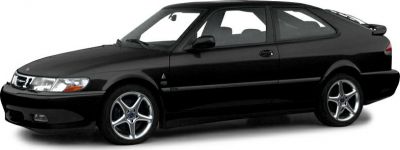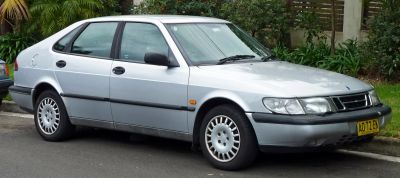 1994 Saab 900 II Combi Coupe Dimensions, Size & Specs
1994 Saab 900 II Combi Coupe Dimensions, Size & SpecsMeasurements of the 1994 Saab 900 II Combi Coupe, engineered for optimal performance and comfort
| Dimensions | |
|---|---|
| Length: | 4637 mm182.6 in15.2 ft |
| Width: | 1711 mm67.4 in5.6 ft |
| Height: | 1436 mm56.5 in4.7 ft |
| Trunk Capacity: | 494 liter17.4 cu ft |
| Trunk Capacity (Max): | 897 liter31.7 cu ft |
| Weight Specifications | |
| Curb Weight: | 1295-1325 kg2855-2921 lbs |
| Maximal permitted Weight: | 1790-1830 kg3946-4034 lbs |
| Tire Specifications | |
| Rims Size: |
|
| Tire Sizes: |
|
The Saab 900 II Combi Coupe, produced from 1993 to 1998 and representing the model year 1994, is a distinctive hatchback that blends practicality with Swedish automotive engineering. This generation of the Saab 900 features a length of 4637 mm (182.6 inches), a width of 1711 mm (67.3 inches), and a height ranging between 1435 mm to 1436 mm (56.5 to 56.5 inches), encapsulating a sleek, aerodynamic profile. Options for tire sizes include 195/60 R15 and 185/65 R15 mounted on 15-inch rims, emphasizing a balance between comfort and performance. The curb weight of the vehicle is between 1295 kg to 1325 kg (2856 to 2921 lbs), while the maximum permissible weight ranges from 1790 kg to 1830 kg (3946 to 4036 lbs), showing a robust yet manageable build for a vehicle of its class. Storage versatility stands out with a generous luggage capacity of 494 liters (17.4 cubic feet) with rear seats up, expandable to 897 liters (31.7 cubic feet) when the rear seats are folded down. This makes the Saab 900 II Combi Coupe an ideal choice among hatchbacks for those needing both stylish design and practical cargo space. Whether evaluating it for comparison or considering it for ownership, the Saab 900 II remains a notable example of mid-1990s hatchback design, combining functional size with distinctive styling and reliable performance.
Discover the standout features that make the 1994 Saab 900 II Combi Coupe a leader in its class
Have a question? Please check our knowledgebase first.
The Saab 900 II Combi Coupe from the 1994 model year measures 4637 mm (182.6 inches) in length, 1711 mm (67.3 inches) in width, and has a height ranging from 1435 to 1436 mm (56.5 to 56.5 inches). These dimensions place the 900 II Combi Coupe in the mid-size hatchback category, offering a good balance between interior space and external footprint. The modern hatchback design allows for a streamlined profile while maintaining practical cabin space for passengers and cargo. Its width provides enough shoulder room for comfort, without making it too bulky for narrow city streets.
The curb weight of the 1994 Saab 900 II Combi Coupe ranges between 1295 kg and 1325 kg (approximately 2856 to 2921 pounds). The maximum permissible weight, which includes passengers and cargo, is between 1790 kg and 1830 kg (approximately 3946 to 4036 pounds). This weight range reflects the car's solid construction and incorporation of safety and comfort features typical of Saab vehicles of the time. The moderate curb weight also offers a balance between performance and fuel efficiency, aiding in responsive handling while maintaining efficiency.
The Saab 900 II Combi Coupe offers a practical luggage capacity of 494 liters (around 17.4 cubic feet) with the rear seats in their upright position, which provides sufficient space for daily shopping, weekend trips, or medium-sized luggage. When the rear seats are folded down, the cargo space expands significantly to 897 liters (approximately 31.7 cubic feet), allowing for larger and bulkier items to be transported with ease. This flexibility in cargo space underscores the vehicle’s versatility as a hatchback, capable of adapting to various passenger and cargo needs.
Yes, the Saab 900 II Combi Coupe fits comfortably into a standard garage. With a length of 4637 mm (182.6 inches), width of 1711 mm (67.3 inches), and height around 1435 mm (56.5 inches), it fits within typical garage dimensions. Most standard residential garages provide around 5.5 to 6 meters (18 to 20 feet) in length and approximately 2.4 to 2.7 meters (8 to 9 feet) in width, so the Saab’s relatively compact footprint ensures ease of parking and maneuvering inside. The moderate height also means that roof clearance for standard garages is not an issue.
Compared to its predecessor, the original Saab 900 Combi Coupe, the 900 II generation saw an increase in overall length, width, and refined styling. While the first generation was known for its more classic, rounded shape and slightly smaller dimensions, the 900 II (produced between 1993 and 1998) was built on the GM-platform, which led to a longer (4637 mm vs approximately 4410 mm), wider (1711 mm vs around 1730 mm - similar but generally wider in perception due to design), and slightly lower profile. This resulted in enhanced interior space, greater stability, and improved handling characteristics, while maintaining the distinctive Saab hatchback design ethos.
In comparison to other mid-1990s hatchbacks like the Volkswagen Golf Mk3, Ford Escort, or Opel Astra, the Saab 900 II Combi Coupe is notably longer and gives an impression of more roomy interior dimensions. For example, the VW Golf Mk3 was around 4175 mm (164.4 inches) in length, which is significantly shorter than the Saab’s 4637 mm (182.6 inches). Width-wise, the Saab’s 1711 mm (67.3 inches) places it roughly on par with these competitors, but its longer wheelbase and overall size offer enhanced passenger comfort and cargo capacity. Thus, in its class, the Saab positioned itself with a more substantial and premium feel while keeping practicality intact.
The Saab 900 II Combi Coupe commonly came equipped with 15-inch rims as standard, paired with tire sizes of 195/60 R15 or alternatively 185/65 R15. These tire dimensions offered a balanced compromise between ride comfort, road grip, and performance characteristics. The 15-inch rims were fairly typical for mid-1990s hatchbacks and contributed to the car's stable handling and smooth ride quality. The available tire options also allowed some flexibility for owners depending on driving preferences and road conditions.
With a height of about 1435 to 1436 mm (56.5 inches), the Saab 900 II Combi Coupe maintains a relatively low and aerodynamic profile, which contributes to a lower center of gravity for improved stability and handling. This aerodynamic advantage helps reduce wind noise and drag, benefiting fuel efficiency and high-speed stability. Internally, despite the lower height, Saab’s design typically emphasized ergonomic seating and driver comfort, ensuring sufficient headroom for average-sized adults without compromising the sporty roofline. The height strikes a practical balance between sleek styling and occupant comfort.
The Saab 900 II Combi Coupe is classified as a hatchback, a body style known for combining passenger comfort with cargo flexibility. Produced from 1993 to 1998, this hatchback catered to drivers seeking a unique blend of sporty driving characteristics, European styling, and practicality. Its hatchback design allows for easy access to the rear luggage area, flexible cargo arrangements, and a roomy rear seat area, making it well suited for daily commuting, family outings, and longer trips that require extra cargo space. Saab's engineering also emphasized safety and driver ergonomics throughout its lineup.
The Saab 900 II Combi Coupe shares much of its size and platform characteristics with the Saab 900 Turbo, particularly in length and width, as both fall within similar dimensional parameters. However, the Turbo variant is distinguished by its higher-performance turbocharged engines, delivering notably stronger acceleration and sporty driving dynamics compared to naturally aspirated counterparts. Dimensionally, both vehicles offer similar spacious interiors and cargo capacities, but the Turbo's added powertrain performance makes it appealing to enthusiasts seeking spirited driving, while the non-Turbo models emphasize comfort and economy. The Turbo also tends to have sportier suspension tuning, which slightly affects ride comfort but enhances cornering capabilities.
Discover similar sized cars.

| Production: | 1998-2002 |
|---|---|
| Model Year: | 1999 |
| Length: | 4629 mm182.2 in |
| Width: | 1711 mm67.4 in |
| Height: | 1428 mm56.2 in |

| Production: | 1993-1998 |
|---|---|
| Model Year: | 1994 |
| Length: | 4637 mm182.6 in |
| Width: | 1711 mm67.4 in |
| Height: | 1436 mm56.5 in |
